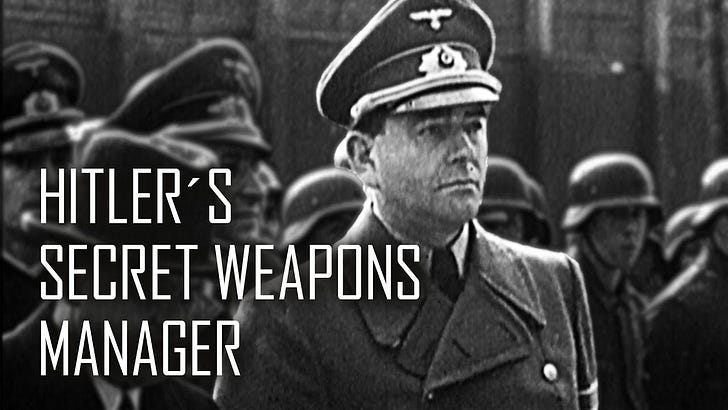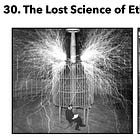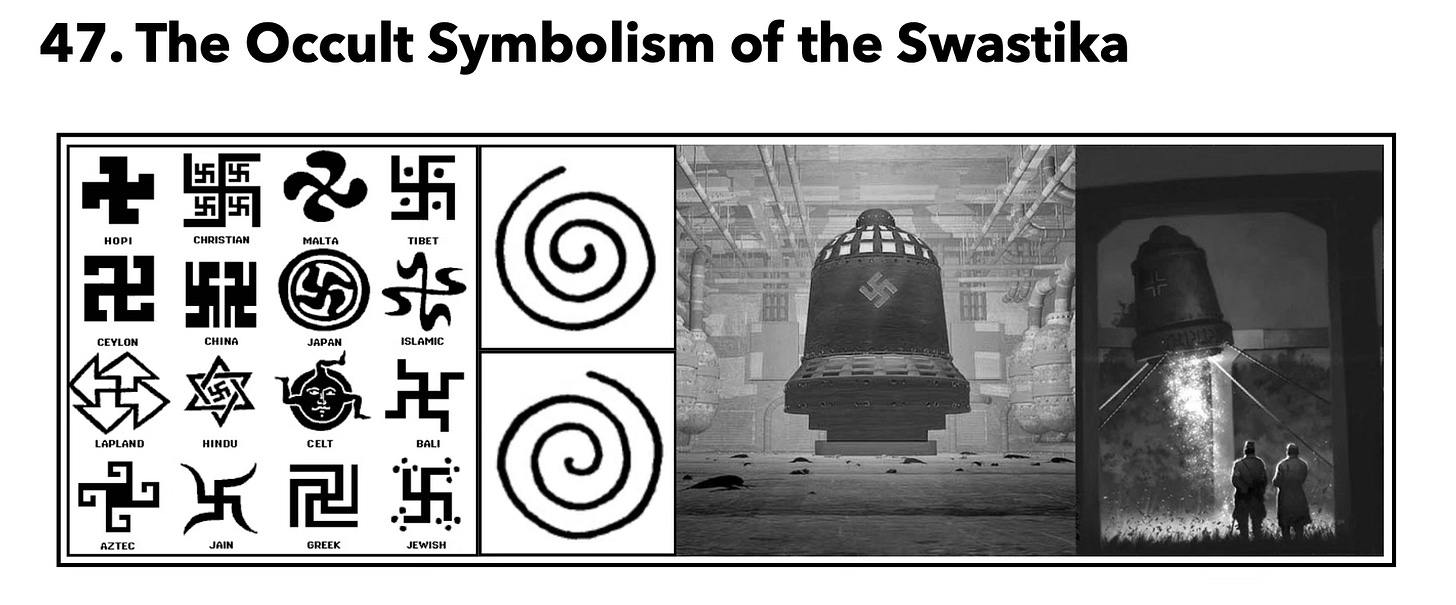The Untold Story of the Nazi "Wonder Weapons"
Two excerpts from my forthcoming book "The Coming World Nation"
This is an excerpt from my new book The Coming World Nation, which is now available on Amazon! It builds on the themes of another excerpt I recently posted:
In that excerpt (which is part of a larger chapter called “The Classified Science of Nikola Tesla”), I introduced the idea that back in the 19th century an alchemically-inspired approach to physics was developed which differs in fundamental ways from the overt doctrines of physics taught in schools today. Most people have never heard of this “exotic” paradigm of physics, which is based around the alchemical concept of the Ether, because it became classified around the turn of the last century and was secreted away into the shadowy inner realms of the US National Security State.
In my book, I analyze the psychological, sociological, philosophical, and historical consequences of keeping this physics paradigm secret. In particular, I explore how this move impacted the development of American Empire and examine the implications for how this empire is governed.
An important part of my analysis of this topic involves delving into the “secret history” of World War II. This includes exploring the existence of a top-secret weapons development program at the heart of the German Wehrmacht. As I discuss in this excerpt, toward the end of the war, scientists working within this covert R&D unit began probing into the mysteries of the Ether. Their goal: to develop a “wonder weapon” that could provide the Nazis with an unexpected and miraculous come-from-behind victory in the war.
In the larger chapter that this excerpt is drawn from, I tell the whole story of this top-secret weapons program (which was named the “Kammlerstab”), beginning with its origins and concluding with an analysis of its final fate. The excerpt that I’m sharing with you today goes into the backstory of Hans Kammler, the mastermind put in charge of its management.
For my paid subscribers, I’m sharing an additional section that discusses the alchemical symbolism of the Nazi Swastika and relates it to the most highly classified of the Kammlerstab’s weapons projects, one codenamed “Die Glocke” or “The Bell”.
p.s. There’s a recent documentary on YouTube about Hans Kammler. It was made by a German production company and features high-quality production value. It doesn’t go into the super exotic projects his organization was pursuing (such as the Bell), but it does touch on the idea that the Kammlerstab produced a workable nuclear weapon (something I also discuss in my book). Here’s a link to the YouTube video of this documentary if you’re interested:
As we just covered, through the influence of secret societies like the Thule Gesellschaft and scholars like Karl Maria Wiligut, the SS directly incorporated occult influences into the formation of its worldview, inspiring not only its bizarre racial beliefs but also the “unorthodox” approach to scientific research and weapons development it would embrace.
As World War II progressed and the tide began to turn against the German Wehrmacht, the SS came to the conclusion that their greatest hope for victory was the invention of a miraculous war-winning weapons technology. To inspire the innovation necessary to create such a device, SS scientists and engineers were instructed to think outside the box of conventional scientific thinking. This meant turning for inspiration to the SS’s storehouse of occult research, which scholars within its “antiquities research department” (the Ahnenerbedienst) had been hard at work stockpiling since the start of the war.
SS chief Heinrich Himmler helped spearhead this effort. He had been a pupil of Wiligut, the influential Austrian occultist, and envisioned using occult knowledge as the basis of a top-secret weapons development program. Here, occult doctrines like alchemy would be combined with modern physics concepts and engineering techniques to inspire an entirely new and exotic approach to weapons development, one that might yield the miraculous “wonder weapon” that SS leaders were increasingly desperate to obtain.
Himmler’s vision became a reality with the creation of the “Kammlerstab”, a top-secret weapons R&D operation concealed within the heart of the SS. It was organized using the hub-and-spoke model of organizational design described earlier, with a central think tank (hub) surrounded by an extended network of compartmentalized outer departments (spokes).
The mastermind Himmler tasked with overseeing this program was a talented engineer named Hans Kammler. After beginning his career in a rather unassuming role within the Nazi Party, Kammler transferred into the ranks of the SS, where he rose quickly in stature and influence. Kammler’s rise within the SS was unusually rapid, in fact: it happened so quickly that researcher Nick Cook described it as nothing less than “meteoric”.
In short order, Kammler, a very eager and ambitious career opportunist, was named head of the SS’s “Building and Works Department”. In this role, he oversaw the design and buildout of several Nazi concentration camps, including the infamous Auschwitz facility. During the war, these camps had as many as 14 million prisoners moving through them. It was a massive engineering and construction effort to engineer this network and Kammler was at the center of the project.
In addition to his official duties, Kammler was given another highly secretive task: he was put in charge of designing and constructing an underground network of highly classified weapons R&D facilities. These housed the SS’s most coveted “black” weapons projects, including those inspired by the Ahnenerbe’s research into the occult. It was here, within the deepest and most shadowy recesses of the Kammlerstab, that SS scientists began probing into the mysteries of the Ether using electromagnetism, with the hope that this new and promising field of research might yield them a “wonder weapon” that could win Germany the war.
What is generally not emphasized in official accounts of WWII history is that there was a close alignment between the locations of Nazi concentration camps and the sites where the SS’s secret underground weapons facilities were buried. The proximity between the two was intentional: the concentration camps were utilized as a source of disposable slave labor that the SS could draw upon for the Kammlerstab's top-secret operations.
The Kammlerstab mined the pool of concentration camp prisoners to build out the physical infrastructure of their top-secret weapons program, much of which was located underground. After the facilities were built-out, these laborers then switched over to provide labor for the research and manufacturing projects being conducted within them.
The plan to use Nazi concentration camps as a source of slave labor was originally developed by Himmler and his economic advisor Oswald Pohl. Journalist Nick Cook explains that “for years, Reichsführer-SS Himmler had harbored a grand scheme to turn the SS … into a self-sustaining economic entity capable of funding and running its affairs without reliance on the everyday financial and administrative mechanisms that maintained and sustained the Reich. It was via the camps that Himmler and his leading economic authority, Oswald Pohl, realized that they could achieve their aims” - and Kammler was the man chosen to fulfill their vision.
Because Kammler was involved in both the buildout of the concentration camps and the construction of the underground research facilities located in their vicinity, he became a hugely important figure within the ranks of the SS.
Kammler proved unusually talented in both engineering and operations management; this made him an ideal candidate to oversee the SS's secret weapons program. Nick Cook emphasizes that it was a role he would lean into and embrace with maniacal zeal: “The sense that the SS gave Kammler free rein to indulge his ideas and ambitions … is unavoidable. No sooner had his appointment (into the SS) taken effect, than he was drawing up detailed plans for the rapid expansion of the camps, egged on by Pohl, who had impressed upon him their value as the engines of growth for his and Himmler's grotesque vision.”
As the war progressed and the prospects for German victory became increasingly dire, Kammler’s influence and importance within the SS correspondingly increased. During the war’s final stages, his responsibilities grew exponentially: he was tasked not only with overseeing the buildout of the SS’s secret research facilities, but also with directly managing the day-to-day operations of the weapons programs they housed. By the war’s end, he was almost singlehandedly masterminding the entire operation.
Many if not all of the top-secret weapons R&D projects that Kammler oversaw were tucked away in underground facilities that concentration camp prisoners had been tasked with constructing, often in brutal and unforgiving conditions. Tens of thousands of inmates died in this effort.
In order to quicken the pace of construction of these underground facilities and to hasten the progress of the weapons programs housed within them, prisoners of Nazi concentration camps like Auschwitz were ruthlessly worked to death and then carelessly tossed aside, with replacement laborers immediately brought in to take their place.
There was an element of extreme desperation at play: the SS was frantically working to bring its experimental weapons technologies up to a point where they could actively be put to use against the Allied powers, who by 1944 had checkmated the Germans against any realistic hope of attaining a conventional military victory. By this point, the SS saw Kammler’s secret weapons operation as its only hope for victory. Consequently, they desperately threw concentration camp laborers by the thousands into its operations, using them callously as a disposable resource to build out their facilities and man their manufacturing production lines.
The Kammlerstab’s operational mandate was to pursue “exotic” scientific ideas of all types: no stone was to be left unturned in the effort of discovering a “wonder weapon” that could win Germany the war. In practice, this meant its scientists were expected to explore untapped, unorthodox dimensions of physics research, ones which departed in fundamental ways from the dogmas of the West’s favored quantum and relativistic models. The SS viewed these as representative of "Jewish physics” and sought to abandon them entirely. In their place, Kammlerstab scientists were instructed to seek out alternative, occult-inspired paradigms of scientific thinking. In this manner, as Joseph Farrell informs us, within the SS “an ideological culture of scientific research and development was established that was vastly different from (that of) the surrounding civilization.”
The most promising alternative physics model that Kammlerstab scientists discovered was one inspired by the Ahnenerbe’s research into alchemy. Specifically, the idea that a universal energy field - the Ether - exists and can be tapped into through electromagnetic means. Zooming out and pondering the significance of what was taking place in the shadowy underbelly of the German Wehrmacht, Farrell writes: “Something else altogether occurred in Nazi Germany; some other paradigm was adopted early on and pursued with all the economic and scientific resources and intellectual brilliance that a modern and technologically sophisticated great power could muster.” Within the underground research facilities of the SS, “a whole new paradigm of physics - a combination of vortex ether, quantum electrodynamics, and nuclear physics - appears not only to have been outlined, but conceptually and experimentally developed.”
Just as the engineers behind the “flying airship” technologies had done a century earlier in America, scientists within the Kammlerstab had begun experimenting with ways to harness the energetic possibilities of the Ether. It’s important to note, however, that in their research they were starting from scratch: there’s no indication that they knew that an earlier generation of scientists in America had pursued research into this paradigm and developed successful technological prototypes using it. Instead of building off the work of these older American programs, Kammlerstab scientists appear to have been forced to start from scratch and build upward from square one. This is significant, because it suggests that an older and more advanced scientific research institution may have existed secretly in America without the SS’s knowledge.
The headquarters of Kammler’s classified think tank was located in Pilsen, Czechoslovakia, where it was cleverly concealed within the engineering division of the Skoda Munitions works. From this main office, Kammler’s team oversaw a vast network of facilities, which branched out from the Pilsen region and extended into Germany, Poland, and Austria. The most important of these were located underground, concealed from the prying eyes of Western intelligence agents.
Farrell observes that the SS’s decision to center its top-secret weapons development research inside of Bohemian Czechoslovakia “was entirely logical, for Bohemia had been made a Reich Protectorate, and fell under the immediate jurisdiction of the SS. The SS had, in effect, turned all of Bohemia into a military reservation, which to enter or leave required proper S.S. authorization and clearances.”
“Within this ‘secure zone,’ with its Gestapo agents crawling the countryside, ferreting out sedition, Kammler’s think tank was surrounded with a triple belt of security of political, economic, and technological counterintelligence.” In essence, the whole region was turned “into the Nazi equivalent of the Nevada test ranges. And within this already cloistered country, Kammler had turned the engineering division of the Skoda Works into the nerve center of a vast secret weapons empire, a veritable rats’ run of underground laboratories and production facilities.”
The projects being pursued within the Kammlerstab were tagged with various levels of classification and secrecy, with each grade given depending on how important the SS leadership deemed that particular project as being to the overall success of the war effort.
The lower levels of this classification scheme contained projects like ballistic missiles and fighter jets, which were more advanced in their design and performance capability than anything the Allied powers possessed in their arsenal during the war.
At a higher level of classification above these was the SS’s nuclear weapons program. While mainstream WWII historical accounts insist that Germany's attempt at building a workable nuclear device had been a failure, credible reports indicate that in actuality a deeply hidden program within the Kammlerstab had successfully developed a working bomb, doing so as early as 1944. Apparently, its scientists had undertaken one or more successful tests of their device, but for a litany of reasons weren’t able or willing to make use of it by war’s end. (See Joseph P. Farrell’s book Reich of the Black Sun for more on this. He argues that an elite faction within the SS traded this nuclear technology to the Americans in exchange for extradition to South America.)
Finally, at the highest and most secret level of the Kammlerstab’s classification scheme were the most exotic of its weapons projects. This includes a device termed the “Bell”, which Kammlerstab scientists treated as their ultimate hope for a “wonder weapon”. From what contemporary scholars like Igor Witkowski have been able can gather, the orientation of this mysterious project involved harnessing the power of the Ether in some unknown capacity. Whatever the device did, the SS were impressed by it enough to title it their “Wunderwaffe” or “miracle weapon”.
We’ll delve into more details about the Bell project later on, but for now let’s consider an important point about the state of technological innovation being developed within Nazi Germany: in almost every way, the top-secret weapons technologies that Kammlerstab scientists were inventing and prototyping were years if not decades ahead of what the overt American military - locked within the frameworks of general relatively and quantum mechanics - possessed or could even conceive.
Evidence suggests that, immediately after the war ended, US intelligence personnel moved with speed and purpose into the Kammlerstab’s underground weapons facilities, having somehow been tipped off to their existence. Entering into its underground laboratories, they were shocked, amazed, and horrified by how far in advance the SS’s technological inventions were in comparison with those of their own country.
In their view, the war had ended just in the nick of time; a few months longer and Kammlerstab scientists may have perfected one of their game-changing “wonder weapons” and put it to use against the Allied powers, thereby pulling off a miraculous, last second, come-from-behind victory in the war.
In the previous section, we discussed how the SS’s infatuation with the occult inspired it to pursue the development of unorthodox weapons technologies of various types inspired by ancient esoteric concepts and formulas. Its ultimate goal was to invent game-changing “wonder weapons” that could be deployed against Germany’s adversaries to turn the tide of the war and provide the Reich with an unexpected last-minute victory.







